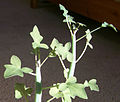
Justicia brandegeeana, the Mexican shrimp plant, shrimp plant or false hop, is an evergreen shrub in the genus Justicia of the acanthus family Acanthaceae, native to Mexico, and also naturalized in Florida.
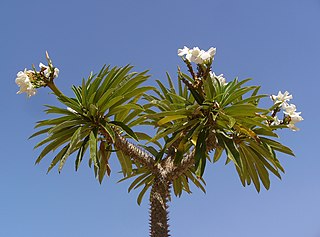
Pachypodium lamerei is a species of flowering plant in the family Apocynaceae. It is a stem succulent, photosynthesizing mainly through its trunk, and comes from the island of Madagascar, off the east coast of Africa. It has large thorns and leaves mostly just at the top of the plant, and large, fragrant flowers. The species has become one of the best known pachypodiums in cultivation, being relatively easy to propagate and grow. In cultivation it is often marketed as the Madagascar palm, despite its not being a palm at all. A variety called "Ramosum" has been described. It is distinguished mostly by a dwarf growth habit and its more rounded corolla lobe.

Abutilon pictum, syn. Abutilon striatum (disputed), is a species of flowering plant in the family Malvaceae. It is native to southern Brazil, Argentina, Paraguay and Uruguay. The plant has become naturalised in Central America, and is used in horticulture. Common names include redvein abutilon, red vein Indian mallow, redvein flowering maple, Chinese-lantern and red vein Chinese lanterns.
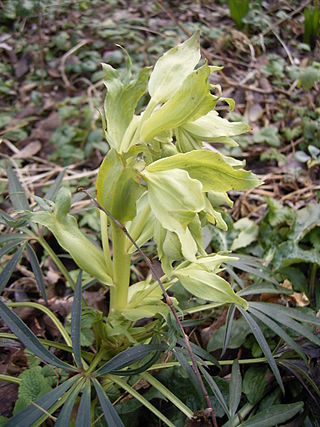
Helleborus foetidus, known variously as stinking hellebore, dungwort, setterwort and bear's foot, is a species of flowering plant in the buttercup family Ranunculaceae, native to the mountainous regions of Central and Southern Europe and Asia Minor. It is found wild in many parts of England, especially on limestone soil.
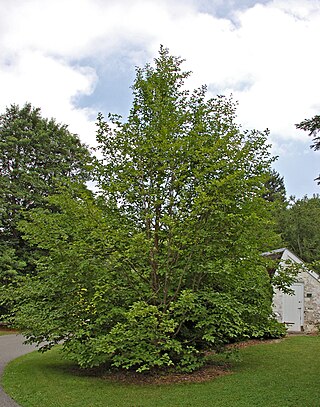
Stewartia pseudocamellia, also known as Korean stewartia, Japanese stewartia, or deciduous camellia, is a species of flowering plant in the family Theaceae, native to Japan and Korea.

Impatiens repens, the Ceylon balsam, yellow impatiens, or creeping balsam, is a species of flowering plant in the family Balsaminaceae, from Sri Lanka. As the Latin name repens indicates, it is a low-growing plant with a creeping habit. This evergreen perennial can be found in wet-zone rain forests. Growing to 50 cm (20 in) tall and broad, it has small kidney-shaped leaves borne on red stems, and hooded yellow flowers in summer and autumn. It can be seen cultivated in gardens as an ornamental plant. In temperate zones it must be protected from temperatures below 10 °C (50 °F), so must be grown under glass during the winter months, It requires a sheltered position in partial shade.
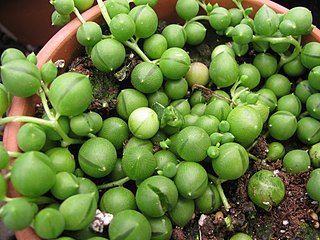
Curio rowleyanus, syn. Senecio rowleyanus, is a flowering plant in the daisy family Asteraceae. It is a creeping, perennial, succulent vine native to the Cape Provinces of South Africa. In its natural environment its stems trail on the ground, rooting where they touch and form dense mats. It often avoids direct sunlight by growing in the shade of other plants and rocks. It is commonly known as string-of-pearls or string-of-beads.

Farfugium japonicum is a species of flowering plant in the family Asteraceae, also known as leopard plant, green leopard plant or tractor seat plant. It is native to streams and seashores of Japan, where it is called tsuwabuki (石蕗).

Kleinia petraea is a species of flowering plant in the genus Kleinia and family Asteraceae which was previously considered to be a species of Senecio. Native to Kenya and Tanzania, it is colloquially known as creeping jade, trailing jade or weeping jade due to its resemblance to the unrelated Jade plant.

Curio repens is a species of succulent groundcover plant in the genus Curio, in the Asteraceae family. Commonly named blue chalksticks, blue chalk fingers and also snake ragwort, it is frequently used in Mediterranean climate landscaping and as an ornamental plant.
× Heucherella is an evergreen perennial flowering plant in the family Saxifragaceae. A hybrid of garden origin, it is the result of a cross between two distinct genera, Heuchera and Tiarella, and shows similarities to both parents. This type of intergeneric hybrid is quite rare, and is indicated by a multiplication symbol before the name. The name Heucherella is an example of a portmanteau word, a combination of the two parents' names.
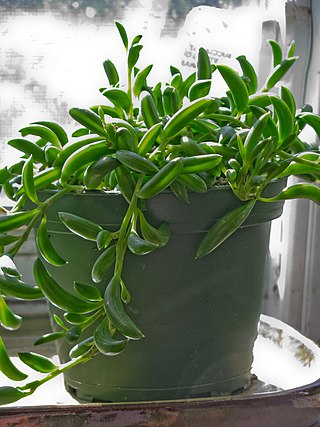
Curio radicans, syn. Senecio radicans, is a succulent plant native to Southern Africa. A member of the family Asteraceae, the asters, this species is closely related to the common string of pearls and Curio hallianus. It has multiple tendrils of glossy, banana-shaped leaves. It is commonly known as string of bananas or fishhook senecio.

Crassula capitella, is a perennial succulent plant native to southern Africa.

Crassula ovata, commonly known as jade plant, lucky plant, money plant or money tree, is a succulent plant with small pink or white flowers that is native to the KwaZulu-Natal and Eastern Cape provinces of South Africa, and Mozambique; it is common as a houseplant worldwide. Much of its popularity stems from the low levels of care needed; the jade plant requires little water and can survive in most indoor conditions. It is sometimes referred to as the money tree; however, Pachira aquatica also has this nickname.

Gasteria baylissiana, or Suurberg gasteria, is a species of succulent flowering plant in the family Asphodelaceae native to the Eastern Cape, South Africa.

Orbea variegata is a species of flowering plant in the family Apocynaceae, known as the star flower. It is native to the coastal belt of the Western Cape, South Africa, growing actively during the winter rainfall season. It is an invasive species in southern Australia.

The Conquista rose, registered under the name 'RUICH1069A', is a modern soft pink hybrid tea rose cultivar developed in Holland by De Ruiter Innovations B.V. and introduced in 2014. Conquista is a Spanish term meaning "conquest".

Plectranthus oertendahlii is a species of flowering plant in the sage and mint family, Lamiaceae. Common names include silverleaf spurflower, Swedish ivy, Oertendahl's spurflower, November lights and Brazilian coleus, though it is native to eastern South Africa rather than Brazil. Plectranthus oertendahlii and the cultivar 'Uvongo' have gained the Royal Horticultural Society's Award of Garden Merit.

Curio × peregrinus, also known as dolphin necklace, flying dolphins, string of dolphins, dolphin plant or Senecio hippogriff, is a succulent nothospecies of Curio in the family Asteraceae. It is often called, incorrectly, Senecio peregrinus, but that name was previously given, by Grisebach in 1879, to a different species from South America. The name Curio × peregrinus was published in 1999, based on the earlier name Kleinia peregrina; however, this name was not validly published. The plant is a hybrid between Curio rowleyanus and Curio articulatus.

Senecio tropaeolifolius, which is known as false nasturtium or nasturtium-leaf spearhead is a succulent plant in the family Asteraceae that is native to South Africa.



